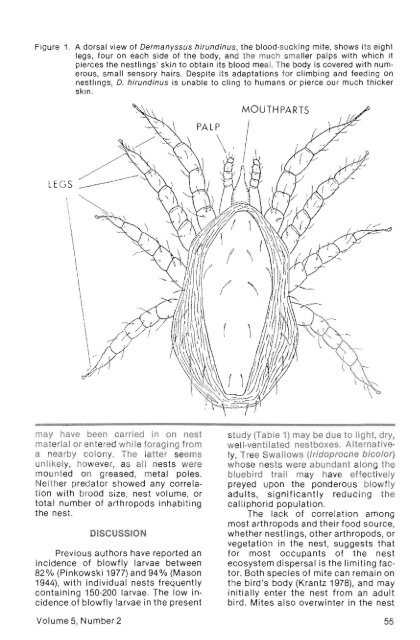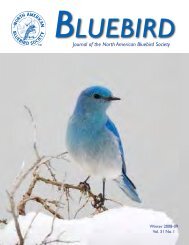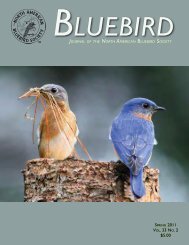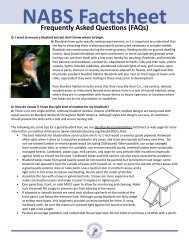Vol. 5, No. 2; Spring 1983 - North American Bluebird Society
Vol. 5, No. 2; Spring 1983 - North American Bluebird Society
Vol. 5, No. 2; Spring 1983 - North American Bluebird Society
Create successful ePaper yourself
Turn your PDF publications into a flip-book with our unique Google optimized e-Paper software.
Figure 1. A dorsal view of Dermanyssus ntrunotnus, the blood-sucking mite, shows its eight<br />
legs, four on each side of the body, and the much smaller palps with which it<br />
pierces the nestlings ' skin to obtain its blood meal. The body is covered with numerous,<br />
small sensory hairs. Despite its adaptations for climb ing and feeding on<br />
nestlings , D. hir undinus is unable lo cling to humans or pierce our much thicker<br />
skin.<br />
MOUTHPARTS<br />
LE GS<br />
may have been carried in on nest<br />
materia l or ent ere d while foraging from<br />
a nearby col ony. The latt er seems<br />
unli kely, howe ver, as all nests were<br />
mounted on greased, metal poles.<br />
Neith er predat or showed any correlat<br />
ion with brood size, nest volume, or<br />
total number of arthropods inhabiting<br />
the nest.<br />
DISCUSSION<br />
Previous authors have reported an<br />
incidence of blowfly larvae between<br />
82% (Pinkowski 1977) and 94% (Mason<br />
1944), with individual nests frequently<br />
containing 150-200 larvae. The low incidence<br />
of blowfly larvae in the present<br />
<strong>Vol</strong>ume5, Number2<br />
st udy (Table 1) may be due to light, dry ,<br />
well-ventilated nestboxes. Alternatively,<br />
Tree Swallows (Iridoprocne bicolor)<br />
wh ose nest s were abundant along the<br />
bluebird trail may have effect ively<br />
preyed upon the ponderous bl owfly<br />
adults, significantly reducing t he<br />
cal liphorid population.<br />
The lack of correlation among<br />
most arthropods and their food source,<br />
whether nestlings, other arthropods, or<br />
vegetation in the nest, suggests that<br />
for most occupants of the nest<br />
ecosystem dispersal is the limiting factor.<br />
Both species of mite can remain on<br />
the bird's body (Krantz 1978), and may<br />
initially enter the nest fr om an adult<br />
bi rd. Mites also overwinter in the nest<br />
55





